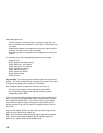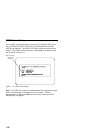If you add or change a drive, you must select the correct drive type on this
screen. If you are adding a hard disk or CD/DVD-ROM to the computer, see
“System Board Layout—Type A-1” on page 5-2 and “System Board
Layout—Type A-2” on page 5-5. If both a CD/DVD-ROM drive and a hard
disk drive are installed, the jumpers on the hard disk drive must be set to
master for the hard drive to appear as Drive 3 on the Setup Utility screen.
The CD/DVD-ROM must be set as the slave device. It will appear as Drive
4 on the screen.
If a hard disk is the only drive attached to the secondary hard disk drive
connector, it appears as Drive 3 on the Setup Utility screen. If two hard
disks are attached to this connector, they appear as Drives 3 and 4 on the
screen.
Input/Output Ports:
This screen allows you to change the serial and
parallel port addresses. Mouse and keyboard information is also provided
on this screen.
The computer has one serial port and one parallel port. Each port has a
special address (identifying location) assigned to it. If you add any additional
serial or parallel port adapters, make sure that each port has a different
address.
The serial port A default address is 2F8-IRQ3.
The parallel port default address is 3BCh.
Other serial and parallel port addresses are available. However, if you
change an address on this screen, you might also need to make changes to
the software. For instructions on changing the software, see the user’s
guide or online information supplied with the software.
The Parallel Port Mode allows you to change the mode of the parallel port.
The standard mode for the parallel port is the Compatible mode. You can
increase the efficiency of the parallel port by using Enhanced modes with
supporting hardware.
Note: The Enhanced modes use recent technology and are only supported
by newer hardware (such as a printer).
If you change the mode of the parallel port, you might need to make
changes to the supported hardware and its software.
Power Management:
This screen provides information about the Power
Management features. Power Management puts the computer in a low
power state when the suspend function is invoked in the operating system.
See “Using Power Management Utilities” on page 1-24 for more information.
General Information 1-21


















